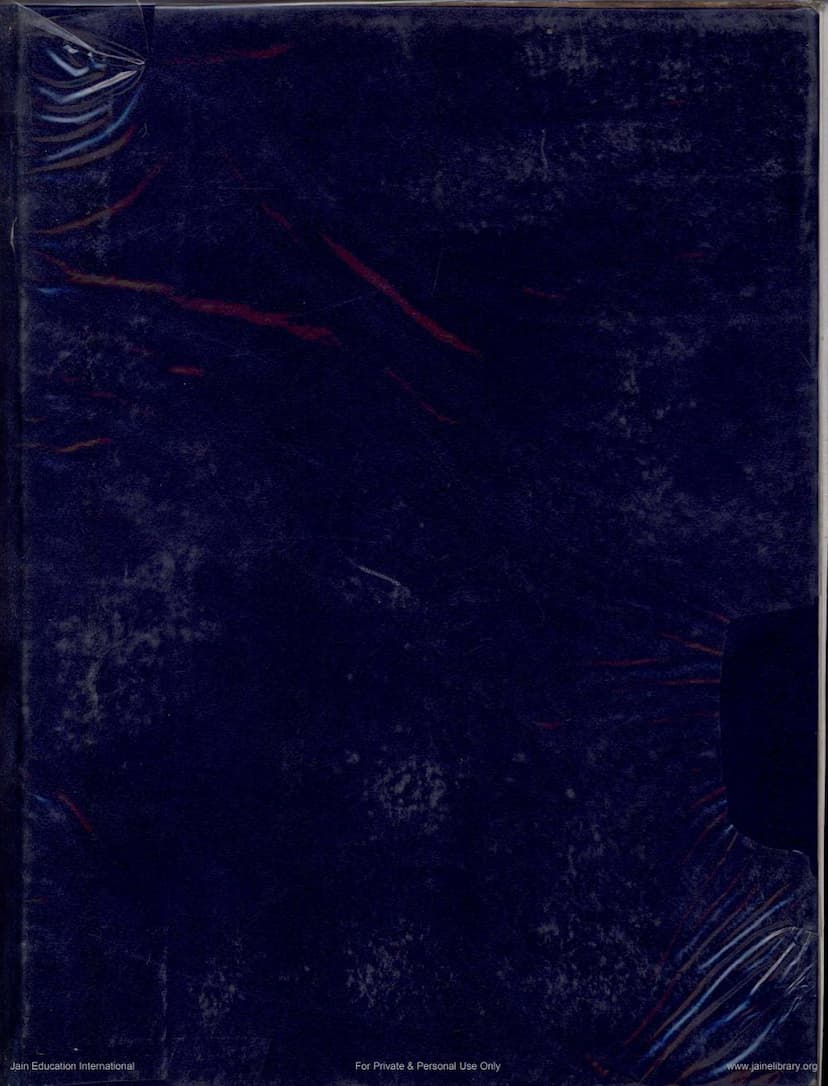Jain Rup Mandan
Added to library: September 2, 2025
Loading image...

Summary
Here's a comprehensive summary of the Jain text "Jaina Rup Mandan (Jaina Iconography)" by Umakant P. Shah, based on the provided pages:
Overview:
- Jaina Rup Mandan (Jaina Iconography) by Dr. Umakant P. Shah is a foundational and authoritative work on the visual representations of deities and symbols within Jainism. It is recognized as a standard textbook and a valuable guide for students of Indian art, archaeology, and museum curators.
- The book aims to provide solutions to complex problems in Jaina iconography, supported by extensive evidence from archaeological findings and literary sources, including previously unpublished manuscripts.
- The work is presented as Volume I, with further volumes planned, and is profusely illustrated with monochrome and color plates.
Key Themes and Content:
-
Historical Context of Jaina Art:
- The book begins by tracing the history of Jaina art and iconography, acknowledging contributions from earlier scholars like Cunningham, Bühler, Smith, Burgess, Growse, Vogel, Bhandarkar, Banerji, Coomaraswamy, and Ramachandran.
- It highlights key archaeological discoveries, such as the Akota Hoard of Jaina Bronzes, which provided crucial insights into the age of differentiation between Digambara and Svetambara images, the introduction of cognizances, and the identification of specific iconographic types like Jivantasvami.
- The author emphasizes the scientific basis of his approach, drawing from both archaeological and literary evidence, including unpublished Sanskrit, Prakrit, Apabhramsa, and Gujarati texts.
-
Sects and Origins:
- The text delves into the origins of Jainism, mentioning its contemporary relationship with Buddhism and its founders.
- It explains the fundamental schism between the Svetämbara (white-robed) and Digambara (sky-clad) sects, discussing their core doctrinal and iconographic differences, such as nudity, the depiction of clothing on Tirthankara images, and the number of heavens.
- The book traces the gradual development of these differences and their impact on Jaina iconography, particularly in the period following the 5th century AD.
-
Jaina Cosmology and Pantheon:
- A significant portion of the work is dedicated to explaining the intricate Jaina cosmology, including the structure of the universe (loka), the different worlds (lower, middle, upper), the island continents (dvipas) and oceans, Mount Meru, and the various heavens (kalpas).
- It details the classification of Jaina deities into four main groups: Bhavanavāsis, Vyantaras, Jyotiskas, and Vimanavāsis, providing iconographic details for each class, including their symbols, complexions, garments, and associated Caitya-trees.
- The text explores the concept of the Pañca-Parameṣṭhis (Arhat, Siddha, Ācārya, Upādhyāya, Sādhus) as the supreme objects of veneration and their symbolic representation in diagrams like the Siddha-Cakra or Nava-Pada.
-
Origin and Evolution of Jina Images:
- The book investigates the origins of image worship in Jainism, suggesting it dates back to at least the Mauryan age (3rd century BC), referencing the Lohanipur torso as early evidence.
- It discusses the tradition of the Jīvantasvāmi-pratimā, an image of Mahavira fashioned during his lifetime, likely from sandalwood, and its subsequent influence on Jaina iconography.
- The text meticulously examines the evolution of Tirthankara images, from the early nude figures (Kushan period) to the later depictions with lower garments (Svetambara tradition) and the distinctive markings that help identify individual Tirthankaras, such as the lāñchana (cognizance) symbols.
- It details the various postures (kāyotsarga and padmāsana/ardha-padmāsana) and the gradual development of the parikara (aura or retinue of figures) surrounding Jina images.
-
Iconography of Specific Deities and Concepts:
- Tirthankaras: The book provides detailed iconographic descriptions of all 24 Tirthankaras of the present age (Avasarpiņi), including their complexions, lāñchanas (cognizances), Caitya-trees, attendant Yakṣas and Yakṣiṇis, and the events of their lives (kalyāṇakas). It notes the differences between Svetambara and Digambara traditions regarding certain details, such as the sex of Mallinātha.
- Parents of Tirthankaras: It discusses the veneration of Tirthankara parents, particularly the mothers, and analyzes various artistic representations of the nativity scenes and the dreams seen by the mothers.
- Kulakaras and Śalākāpuruṣas: The work covers the iconography of Kulakaras (early law-givers) and the Śalākāpuruṣas (great men of the Jaina tradition), including Cakravartins, Vasudevas, Baladevas, and Prati-Vasudevas, noting their associated symbols and influences from Brahmanical traditions.
- Symbol Worship: It discusses the worship of various symbols like the Dharma-cakra, Stambhas (pillars), Caitya-trees, Āyāgapāṭas, Aṣṭamaṅgalas (eight auspicious symbols), and others.
- Cosmographical Representations: The book explores the visual representations of cosmographical concepts like Nandiśvara-dvipa and Samavasaraṇa (the sermon hall of a Tirthankara).
- Sāsanadevatās: It provides an in-depth study of the Yakṣa and Yakṣi cult in Jainism, tracing their origins, classification, and their incorporation as attendant deities (Śāsanadevatās) to the Tirthankaras. It highlights the evolution of these attendant figures, from generic Yakṣas to specific ones associated with individual Tirthankaras, and the influence of Brahmanical and Buddhist traditions.
- Other Deities: The text touches upon the worship of other deities like the Vidyādevis, Kṣetrapāla, Mātṛkās, and the assimilation of Brahmanical deities like Ganesa and Durga into the Jaina pantheon.
Methodology and Scholarship:
- Dr. Shah's approach is characterized by meticulous research, integrating archaeological evidence (sculptures, inscriptions, hoards) with literary sources (canonical texts, commentaries, Purāṇas).
- He addresses scholarly debates and resolves iconographic ambiguities by presenting evidence and offering reasoned conclusions.
- The book acknowledges the living nature of Jainism and the continuous evolution of its art and practices, while also striving to trace the origins and development of iconographic forms.
In essence, "Jaina Rup Mandan" is a monumental scholarly work that systematically deciphers the visual language of Jainism, offering a comprehensive understanding of its iconography, cosmology, and the historical development of its religious imagery.